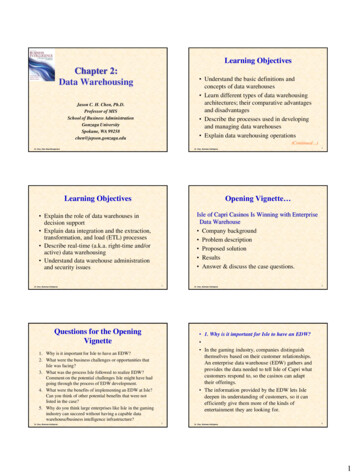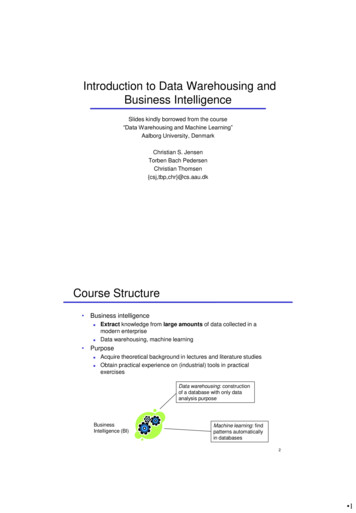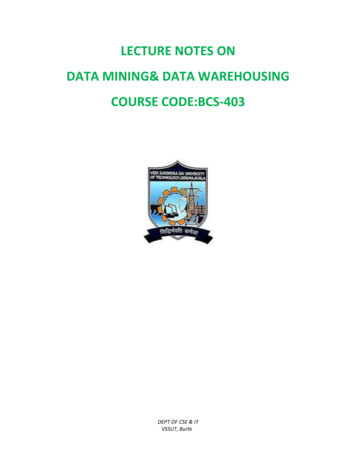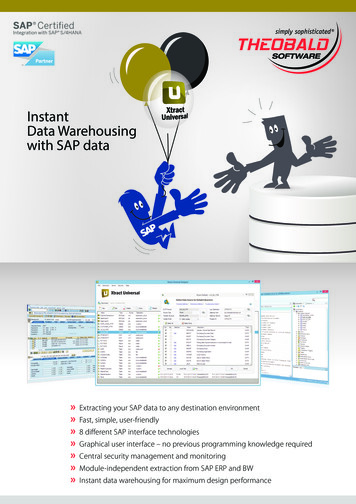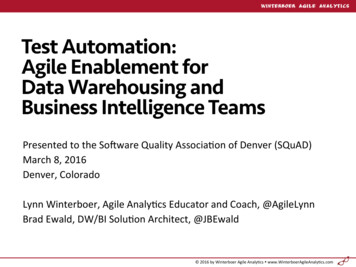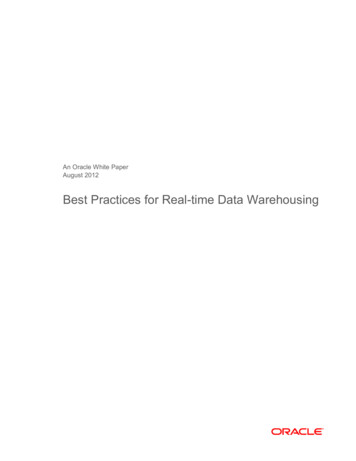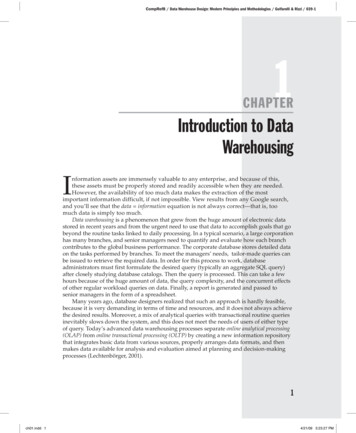
Transcription
CompRef8 / Data Warehouse Design: Modern Principles and Methodologies / Golfarelli & Rizzi / 039-11CHAPTERIntroduction to DataWarehousingInformation assets are immensely valuable to any enterprise, and because of this,these assets must be properly stored and readily accessible when they are needed.However, the availability of too much data makes the extraction of the mostimportant information difficult, if not impossible. View results from any Google search,and you’ll see that the data information equation is not always correct—that is, toomuch data is simply too much.Data warehousing is a phenomenon that grew from the huge amount of electronic datastored in recent years and from the urgent need to use that data to accomplish goals that gobeyond the routine tasks linked to daily processing. In a typical scenario, a large corporationhas many branches, and senior managers need to quantify and evaluate how each branchcontributes to the global business performance. The corporate database stores detailed dataon the tasks performed by branches. To meet the managers’ needs, tailor-made queries canbe issued to retrieve the required data. In order for this process to work, databaseadministrators must first formulate the desired query (typically an aggregate SQL query)after closely studying database catalogs. Then the query is processed. This can take a fewhours because of the huge amount of data, the query complexity, and the concurrent effectsof other regular workload queries on data. Finally, a report is generated and passed tosenior managers in the form of a spreadsheet.Many years ago, database designers realized that such an approach is hardly feasible,because it is very demanding in terms of time and resources, and it does not always achievethe desired results. Moreover, a mix of analytical queries with transactional routine queriesinevitably slows down the system, and this does not meet the needs of users of either typeof query. Today’s advanced data warehousing processes separate online analytical processing(OLAP) from online transactional processing (OLTP) by creating a new information repositorythat integrates basic data from various sources, properly arranges data formats, and thenmakes data available for analysis and evaluation aimed at planning and decision-makingprocesses (Lechtenbörger, 2001).1ch01.indd 14/21/09 3:23:27 PM
CompRef8 / Data Warehouse Design: Modern Principles and Methodologies / Golfarelli & Rizzi / 039-12Data Warehouse Design: Modern Principles and MethodologiesLet’s review some fields of application for which data warehouse technologies aresuccessfully used: Trade Sales and claims analyses, shipment and inventory control, customer careand public relations Craftsmanship Production cost control, supplier and order support Financial services Risk analysis and credit cards, fraud detection Transport industry Vehicle management Telecommunication services Call flow analysis and customer profile analysis Health care service Patient admission and discharge analysis and bookkeeping inaccounts departmentsThe field of application of data warehouse systems is not only restricted to enterprises,but it also ranges from epidemiology to demography, from natural science to education.A property that is common to all fields is the need for storage and query tools to retrieveinformation summaries easily and quickly from the huge amount of data stored indatabases or made available by the Internet. This kind of information allows us to studybusiness phenomena, learn about meaningful correlations, and gain useful knowledge tosupport decision-making processes.1.1 Decision Support SystemsUntil the mid-1980s, enterprise databases stored only operational data—data created bybusiness operations involved in daily management processes, such as purchase management,sales management, and invoicing. However, every enterprise must have quick, comprehensiveaccess to the information required by decision-making processes. This strategic information isextracted mainly from the huge amount of operational data stored in enterprise databases bymeans of a progressive selection and aggregation process shown in Figure 1-1.FIGURE 1-1Information valueas a function ofquantitych01.indd 24/21/09 3:23:28 PM
CompRef8 / Data Warehouse Design: Modern Principles and Methodologies / Golfarelli & Rizzi / 039-1Chapter 1:Introduction to Data Warehousing3An exponential increase in operational data has made computers the only tools suitablefor providing data for decision-making performed by business managers. This fact hasdramatically affected the role of enterprise databases and fostered the introduction ofdecision support systems. The concept of decision support systems mainly evolved from tworesearch fields: theoretical studies on decision-making processes for organizations andtechnical research on interactive IT systems. However, the decision support system conceptis based on several disciplines, such as databases, artificial intelligence, man-machineinteraction, and simulation. Decision support systems became a research field in the mid’70s and became more popular in the ’80s.Decision Support SystemA decision support system (DSS) is a set of expandable, interactive IT techniques andtools designed for processing and analyzing data and for supporting managersin decision making. To do this, the system matches individual resources of managerswith computer resources to improve the quality of the decisions made.In practice, a DSS is an IT system that helps managers make decisions or choose amongdifferent alternatives. The system provides value estimates for each alternative, allowing themanager to critically review the results. Table 1-1 shows a possible classification of DSSs onthe basis of their functions (Power, 2002).From the architectural viewpoint, a DSS typically includes a model-based managementsystem connected to a knowledge engine and, of course, an interactive graphical userinterface (Sprague and Carlson, 1982). Data warehouse systems have been managing thedata back-ends of DSSs since the 1990s. They must retrieve useful information from a hugeamount of data stored on heterogeneous platforms. In this way, decision-makers canformulate their queries and conduct complex analyses on relevant information withoutslowing down operational systems.SystemDescriptionPassive DSSSupports decision-making processes, but it does not offerexplicit suggestions on decisions or solutions.Active DSSOffers suggestions and solutions.Collaborative DSSOperates interactively and allows decision-makers tomodify, integrate, or refine suggestions given by the system.Suggestions are sent back to the system for validation.Model-driven DSSEnhances management of statistical, financial, optimization,and simulation models.Communication-driven DSSSupports a group of people working on a common task.Data-driven DSSEnhances the access and management of time series ofcorporate and external data.Document-driven DSSManages and processes nonstructured data in many formats.Knowledge-driven DSSProvides problem-solving features in the form of facts, rules,and procedures.TABLE 1-1ch01.indd 3Classification of Decision Support Systems4/21/09 3:23:28 PM
CompRef8 / Data Warehouse Design: Modern Principles and Methodologies / Golfarelli & Rizzi / 039-14Data Warehouse Design: Modern Principles and Methodologies1.2 Data WarehousingData warehouse systems are probably the systems to which academic communities andindustrial bodies have been paying the greatest attention among all the DSSs. Datawarehousing can be informally defined as follows:Data WarehousingData warehousing is a collection of methods, techniques, and tools used to supportknowledge workers—senior managers, directors, managers, and analysts—to conductdata analyses that help with performing decision-making processes and improvinginformation resources.The definition of data warehousing presented here is intentionally generic; it gives youan idea of the process but does not include specific features of the process. To understand therole and the useful properties of data warehousing completely, you must first understand theneeds that brought it into being. In 1996, R. Kimball efficiently summed up a few claimsfrequently submitted by end users of classic information systems: “We have heaps of data, but we cannot access it!” This shows the frustration of thosewho are responsible for the future of their enterprises but have no technical tools tohelp them extract the required information in a proper format. “How can people playing the same role achieve substantially different results?” In midsizeto large enterprises, many databases are usually available, each devoted to a specificbusiness area. They are often stored on different logical and physical media that arenot conceptually integrated. For this reason, the results achieved in every businessarea are likely to be inconsistent. “We want to select, group, and manipulate data in every possible way!” Decision-makingprocesses cannot always be planned before the decisions are made. End users needa tool that is user-friendly and flexible enough to conduct ad hoc analyses. Theywant to choose which new correlations they need to search for in real time as theyanalyze the information retrieved. “Show me just what matters!” Examining data at the maximum level of detail is notonly useless for decision-making processes, but is also self-defeating, because itdoes not allow users to focus their attention on meaningful information. “Everyone knows that some data is wrong!” This is another sore point. An appreciablepercentage of transactional data is not correct—or it is unavailable. It is clear that youcannot achieve good results if you base your analyses on incorrect or incomplete data.We can use the previous list of problems and difficulties to extract a list of key wordsthat become distinguishing marks and essential requirements for a data warehouse process, aset of tasks that allow us to turn operational data into decision-making support information: accessibility to users not very familiar with IT and data structures; integration of data on the basis of a standard enterprise model; query flexibility to maximize the advantages obtained from the existing information;ch01.indd 44/21/09 3:23:28 PM
CompRef8 / Data Warehouse Design: Modern Principles and Methodologies / Golfarelli & Rizzi / 039-1Chapter 1:Introduction to Data Warehousing5 information conciseness allowing for target-oriented and effective analyses; multidimensional representation giving users an intuitive and manageable viewof information; correctness and completeness of integrated data.Data warehouses are placed right in the middle of this process and act as repositoriesfor data. They make sure that the requirements set can be fulfilled.Data WarehouseA data warehouse is a collection of data that supports decision-making processes.It provides the following features (Inmon, 2005): It is subject-oriented. It is integrated and consistent. It shows its evolution over time and it is not volatile.Data warehouses are subject-oriented because they hinge on enterprise-specificconcepts, such as customers, products, sales, and orders. On the contrary, operationaldatabases hinge on many different enterprise-specific applications.We put emphasis on integration and consistency because data warehouses take advantageof multiple data sources, such as data extracted from production and then stored to enterprisedatabases, or even data from a third party’s information systems. A data warehouse shouldprovide a unified view of all the data. Generally speaking, we can state that creating a datawarehouse system does not require that new information be added; rather, existinginformation needs rearranging. This implicitly means that an information system should bepreviously available.Operational data usually covers a short period of time, because most transactionsinvolve the latest data. A data warehouse should enable analyses that instead cover a fewyears. For this reason, data warehouses are regularly updated from operational data andkeep on growing. If data were visually represented, it might progress like so: A photographof operational data would be made at regular intervals. The sequence of photographswould be stored to a data warehouse, and results would be shown in a movie that revealsthe status of an enterprise from its foundation until present.Fundamentally, data is never deleted from data warehouses and updates are normallycarried out when data warehouses are offline. This means that data warehouses can beessentially viewed as read-only databases. This satisfies the users’ need for a short analysisquery response time and has other important effects. First, it affects data warehouse–specificdatabase management system (DBMS) technologies, because there is no need for advancedtransaction management techniques required by operational applications. Second, datawarehouses operate in read-only mode, so data warehouse–specific logical design solutionsare completely different from those used for operational databases. For instance, the mostobvious feature of data warehouse relational implementations is that table normalizationcan be given up to partially denormalize tables and improve performance.Other differences between operational databases and data warehouses are connectedwith query types. Operational queries execute transactions that generally read/write ach01.indd 54/21/09 3:23:29 PM
CompRef8 / Data Warehouse Design: Modern Principles and Methodologies / Golfarelli & Rizzi / 039-16Data Warehouse Design: Modern Principles and Methodologiessmall number of tuples from/to many tables connected by simple relations. For example,this applies if you search for the data of a customer in order to insert a new customer order.This kind of query is an OLTP query. On the contrary, the type of query required in datawarehouses is OLAP. It featur
4 Data Warehouse Design: Modern Principles and Methodologies 1.2 Data Warehousing Data warehouse systems are probably the systems to which academic communities and industrial bodies have been paying the greatest attention among all the DSSs. Data warehousing can be informally defined as follows: The definition of data warehousing presented here is intentionally generic; it gives you an idea of .

